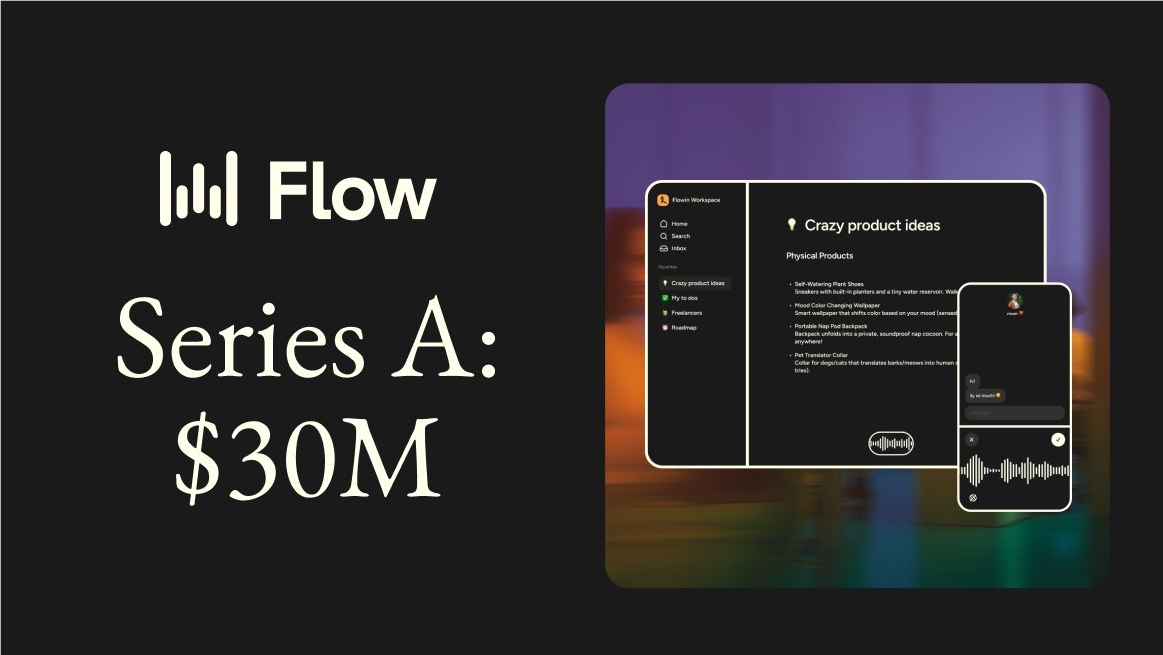Speech input technology startup Wispr Flow announced the completion of a $30 million Series A funding round, led by Menlo Ventures, with participation from NEA, 8VC, Opal CEO Kenneth Schlenker, Pinterest founder Evan Sharp, Carta CEO Henry Ward, and Lindy CEO Flo Crivelli, among other prominent investors. Wispr Flow's total fundraising has now reached $56 million. This funding round will help Wispr Flow expand its AI-driven speech input technology, further challenging traditional keyboard input methods, and opening a new chapter in human-computer interaction. AIbase provides an in-depth analysis of this funding event and its underlying significance.

Wispr Flow: Redefining the Speech Input Experience
Wispr Flow is an AI productivity tool focused on speech input, initially developed for macOS, and has since expanded to Windows and iOS platforms, with plans to launch an Android version in 2025. Its core product, "Flow," allows users to input text through natural speech, up to three to four times faster than traditional keyboard input, and supports over 100 languages. With its ultra-fast inference engine, Flow can convert speech into formatted text in real time, automatically editing redundant parts of spoken language (such as "um" or "uh") and adapting to users' preferred writing styles.
Wispr Flow was founded in 2020 by its CEO Tanay Kothari and co-founder Sahaj Garg, aiming to solve the inefficiency of traditional keyboard input. Kothari said, "Our goal is to make communication more natural, reduce the time users spend staring at screens, and let people focus on more important priorities."
Funding Background and Strategic Direction
This $30 million Series A funding round marks a key milestone in Wispr Flow's development. According to Kothari, the company had not originally planned to raise funds immediately, but considering the distribution advantages of large tech companies in the field of speech AI, it decided to accelerate growth through capital to consolidate its market position.
Use of Funds:
Talent Expansion: Wispr Flow currently has 18 employees and plans to hire more engineers and marketing professionals to speed up product iteration and market penetration.
Platform Expansion: In addition to the already launched macOS, Windows, and iOS apps, the company is developing an Android version and plans to support team-sharing context features through enterprise solutions, meeting the needs of enterprise users for customized terminology.
AI Hardware Collaboration: Wispr Flow is working with undisclosed AI hardware partners to explore integrating speech interaction technology into hardware devices, creating a more seamless human-computer interaction experience.
Market Performance and Competitive Landscape
Since the release of its macOS app in October 2024, Wispr Flow has shown strong growth. It is reported that its user base grows by 50% monthly, revenue increases by 60% month-over-month, and the subscription conversion rate reaches as high as 19%. Especially in the U.S. market, about 40% of users come from this region, showing its broad appeal among professionals and content creators.
However, the speech input market is highly competitive, and Wispr Flow faces challenges from startups such as Aqua, Talktastic, Superwhisper, and Betterdication, which are supported by Y Combinator. Kothari believes that Wispr Flow will stand out in the competition due to its technical expertise and long-term investment by its engineering team.
Wispr Flow's vision goes far beyond being just a speech input tool. Kothari stated that the company is working to turn Flow into an AI assistant like JARVIS in "Iron Man," capable of understanding user context deeply and assisting with daily tasks such as sending messages, taking notes, and setting reminders. This vision expands speech interaction from simple text input to a full-scene AI productivity platform.
Additionally, Wispr Flow's early business focused on developing devices that allow users to input text through lip movements without speaking. Although this direction has shifted to software, its exploration in neural interfaces and AI interaction has laid the foundation for future innovations.
Wispr Flow's $30 million funding not only reflects the investment boom in the speech AI field but also signals a profound transformation in human-computer interaction. AIbase believes that with the advancement of AI technology, speech input is expected to replace keyboards as the mainstream interaction method. Wispr Flow's rapid growth and cross-platform strategy give it the potential to gain an edge in this field.
In the future, Wispr Flow's success will depend on whether it can find a balance between technological innovation, user experience, and market expansion. AIbase will continue to track its performance in the speech AI and enterprise markets, looking forward to providing global users with a more efficient and natural interaction experience.
